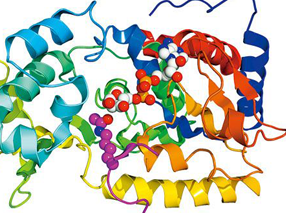编辑推荐:

在一项新研究中,研究人员描述了一种创新性新模型,这种模型不仅使得他们能够在体内追踪耐药,还揭示 了一个新治疗靶点,早期的测试表明这有可能为阻滞胰腺癌的生长提供一种新策略。
胰腺导管腺癌是胰腺癌最常见的类型,其非常的致命,5年生存率仅为6%。化学治疗疗效欠佳,部分原因在于对当前使用的治疗方案高度耐药。
加州大学圣地亚哥医学院和Moores癌症中心的研究人员,与日本庆应义塾大学、 美国内布拉斯加大学和Ionis制药公司的同事们一起描述了一种创新性新模型,这种模型不仅使得他们能够在体内追踪耐药,还揭示了一个新治疗靶点,早期的 测试表明这有可能为阻滞胰腺癌的生长提供一种新策略。
在合作中结合科学与临床专业知识,课题负责人、加州大学圣地亚哥医学院药理学与医学系教授Tannishtha Reya博士,健康和Moores癌症中心外科学系外科肿瘤学教授Andrew Lowy博士,与同事们一起开发出了一种新型“报告”小鼠模型,使得在活体动物体内基于成像、非侵入性地追踪干细胞信号成为可能。
采用这一策略,该研究小组证实干细胞基因Musashi (Msi)是胰腺癌进展中的一个关键元件。尤其是,该研究工作揭示随着癌症的进展Msi表达增高,表达Msi的细胞是癌症生长、耐药及致命性的关键驱动因素。
鉴于Msi在促进侵袭性疾病中所起的作用,研究人员与Ionis制药公司肿瘤药物发现副总裁Robert MacLeod博士合作,开发出了针对Msi的新一代反义寡核苷酸(ASO)抑制剂。这些抑制剂有效地靶向和阻断了表达Msi的细胞,导致动物模型和患者来源的癌细胞中肿瘤生长停止。
反义抑制剂指的是设计出来选择性结合疾病相关靶基因信使RNA并失活它的一种合成核酸药物。
Reya说,这些研究结果可以广泛地用于研究癌症。“由于通过活体成像可以显像Msi报告蛋白活性,可以利用这些模型来追踪肿瘤环境中的癌症干细胞,实时观察癌症生长与转移,并为测试能够更好地消灭耐药细胞的新药提供了一个平台。”
Reya还指出,在原发肿瘤中靶向Msi可“通过抑制癌症干细胞和其他肿瘤细胞,停止胰腺癌生长及提高存活率来显著改变癌症发展的轨迹。这实际上突显了我们能够转化这些研究结果的能力,表明Msi拮抗剂可能是靶向化疗耐药的一种新策略。”
近日,麻省总医院(MGH)的研究人员发现了杀死90%以上患者的最常见胰腺癌形式的第一个潜在分子治疗靶点。发现肿瘤抑制蛋白SIRT6在约 30%的胰腺导管腺癌(PDAC)中失活,该研究小组确定了SIRT6抑制PDAC形成的确切信号通路,这一机制不同于它抑制大肠癌的途径。
加州大学圣塔克鲁兹分校的分子、细胞和发育生物学副教授Jeremy Sanford发现,他一直在研究的一个蛋白质,似乎对于推动胰腺癌细胞的扩散和转移,发挥着重要的作用。这个蛋白质被称为IGF2BP3,表示“胰岛素 样生长因子2 mRNA结合蛋白3”。
中国医学科学院北京协和医学院的研究人员在新研究中揭示,在基因间长链非编码RNA (lincRNA) LINC00673中的一个胰腺癌风险变异为miR-1231构建了一个结合位点,干扰了PTPN11降解。
原文索引:
Image-based detection and targeting of therapy resistance in pancreatic adenocarcinoma
Pancreatic intraepithelial neoplasia is a pre-malignant lesion that can progress to pancreatic ductal adenocarcinoma, a highly lethal malignancy marked by its late stage at clinical presentation and profound drug resistance1. The genomic alterations that commonly occur in pancreatic cancer include activation of KRAS2 and inactivation of p53 and SMAD4 (refs 2, 3, 4). So far, however, it has been challenging to target these pathways therapeutically; thus the search for other key mediators of pancreatic cancer growth remains an important endeavour. Here we show that the stem cell determinant Musashi (Msi) is a critical element of pancreatic cancer progression both in genetic models and in patient-derived xenografts. Specifically, we developed Msi reporter mice that allowed image-based tracking of stem cell signals within cancers, revealing that Msi expression rises as pancreatic intraepithelial neoplasia progresses to adenocarcinoma, and that Msi-expressing cells are key drivers of pancreatic cancer: they preferentially harbour the capacity to propagate adenocarcinoma, are enriched in circulating tumour cells, and are markedly drug resistant. This population could be effectively targeted by deletion of either Msi1 or Msi2, which led to a striking defect in the progression of pancreatic intraepithelial neoplasia to adenocarcinoma and an improvement in overall survival. Msi inhibition also blocked the growth of primary patient-derived tumours, suggesting that this signal is required for human disease. To define the translational potential of this work we developed antisense oligonucleotides against Msi; these showed reliable tumour penetration, uptake and target inhibition, and effectively blocked pancreatic cancer growth. Collectively, these studies highlight Msi reporters as a unique tool to identify therapy resistance, and define Msi signalling as a central regulator of pancreatic cancer.
微信公众号
关注微信订阅号,实时查看信息,关注医学生物学动态。


